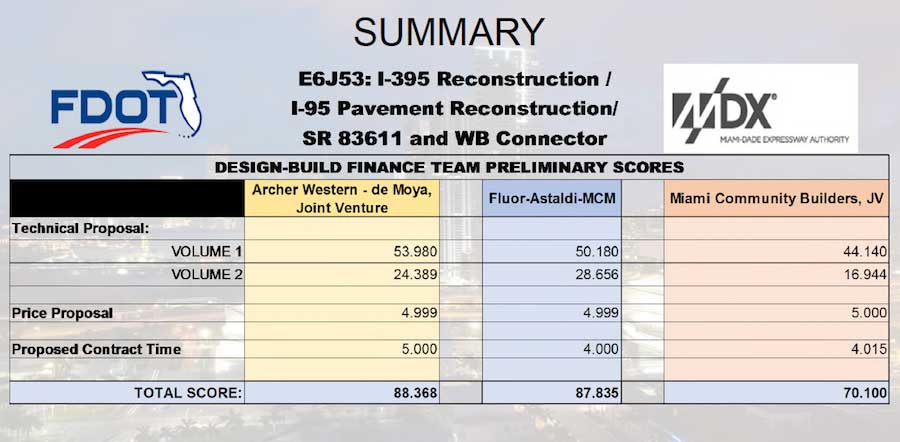Do-overs in best value-based contract awards make almost as much of a mockery of the competitive part of the process as re-bids do in price-only competitions. You only want to see a re-start with a new request for proposals if the original process has gone badly awry.
The process of awarding a contract for one of the highest-profile Florida signature bridge projects since the Sunshine Skyway now seems to be in the express lane back to the state courthouse, where it has been before. The basic conflict is over control of the project between the Florida Dept. of Transportation and opponents in Miami, each of which has its own view of how the plan and team is selected.
The battle over the bridge superstructure and urban design plans for the surrounding area goes back at least until 2013.
The battle over the bridge superstructure and urban design plans for the surrounding area goes back at least until 2013.
Designs shared with the public by FDOT that year compared the cost of bridge superstructures in the form of infinity arches ($740M), wishbone-shaped arches ($673M), and segmental concrete box ($559M). The cost of the current project is put at roughly $800 million.
Plans back in 2013 were also prepared for areas beneath the new span and approach roads with parks and other pedestrian-friendly amenities.
From my risk-averse point of view, the investment of time and energy made by the competing engineers and contractors might as well have been submitted to the state’s Powerball lottery, instead of the FDOT, except that in design and heavy construction the payout is modest.
Okay, that's a bit of an exaggeration. With only four submitters, you start with a one-out-of-four chance of winning and then a one-out-of-three chance after one proposal is eliminated for being non-responsive. But that's only if you don't discount your 33% chance of prevailing by the delays possible from the controversy. When will a successful proposer finally start making a profit on its work?
The essence of the dispute is that, after litigating with community groups over the criteria for selecting the winning team for the I-395 replacement bridge and related construction (a P3, according to the state), FDOT agreed to give more weight to aesthetics in selecting a proposal. Elected officials and community members in Miami claim that FDOT then undercut its promise—“put its thumb on the scale” is one way it has been phrased—to get the project it wanted from the scoring conducted by the technical and aesthetic review committees. The result: a .533-point victory for a joint venture of Archer Western and The deMoya Group over a joint venture of Fluor, Astaldi and MCM. A third team scored much lower.
(See related news story, Florida Bridge Award Thrown Into Doubt By Opposition)
Fluor and Astaldi and MCM have sent FDOT a letter protesting the award, the Miami Herald reports.
Working on the story around the Memorial Day weekend, I'm still waiting for interviews and more data about exactly how the scoring plan was revised. According to the scoring documents provided to ENR by FDOT, the maximum total number of points the three competing teams could score is 90. An initial technical evaluation included criteria such as construction method and design-build value added and contained 60 possible points maximum. A second round of technical evaluation contains items such as “signature span,” lighting, and additional value, for another possible 30 points. A separate aesthetics review committee awarded another possible 30 points to each competitor.
How the Bridge Proposals Differ
Unlike its editorial fingering FDOT’s “Tallahassee bureaucrats” for going back on their word, the Miami Herald also had an evenhanded account pointing out the critical differences between the two top-ranked proposals:
Both of the two top-ranked proposals honor the wishes of the community damaged by the existing infrastructure, Overtown, by raising the roadways and providing pedestrian access to new parks and gardens and public spaces.
Here’s what the Herald says about the Archer Western team’s plan:
“Archer Western plans to double-deck State Road 836 starting west of the Miami River and over I-95 to the rebuilt 395 — an addition its engineers contend will eliminate traffic backups on the new expressway and allow them to finish the project in four years, a year ahead of FDOT’s five-year deadline and its competitors’ schedules. The speedier schedule is possible because most of that viaduct construction would take place outside of existing lanes of traffic, which also reduces the impact on expressway users, said Robert Linares, an engineer on the team.”
And here’s what the Herald says about the competing plan, the one that lost by a nose:
“Fluor-Astaldi manages what might be a coup on the east end of the expressway (No. 5 on the map). Its plan provides for a new 3-acre park to connect Museum Park and its Metromover station to the Arsht [a cultural center], long a goal of planners.”
“That’s made possible by extending its cable-suspended signature bridge toward the east, eliminating a massive, existing support embankment and moving a roadway that now connects northbound Biscayne Boulevard to the MacArthur Causeway to the north side of the new bridge, said the team’s urban designer, Bernard Zyscovich. The park also allows direct access to the bay and a potential landing spot for a promised rail link to Miami Beach.”
The Archer Western version also provides green space, the Herald writes, “under the new bridge and a wider sidewalk on Biscayne Boulevard, but Museum Park remains fenced off, and there is no direct bay access.”
Accusations Against FDOT
The struggle for control of this project also involves accusations that rules were changed and manipulated. I’ll wait to find out what happened and how to interpret it, but in the meantime, someone ought to thank the five-member technical review and the four-member aesthetic review committees for scoring the projects. The cone-of-silence rules observed in this and other procurements, where committee members are cut off during the final part of the selection process from proposals and proponents, is a needed and appropriate method of keeping away pressure groups and influence peddlers, including politicians and corporations.
All I can say is that no matter which highway and bridge plan finally wins, it will give all the interested parties, including the drivers and taxpayers in Florida, a vast improvement. The saddest thing will be if a procurement process is found to have been undermined, as the Herald charges, or is scuttled by unsupported accusations.
Starting over in a completely new procurement process can be a good idea—it was needed for the award of the program management contract for the Miami-Dade County sewer overhaul. But starting over could delay the bridge and highway work for years, depriving Floridians of the benefits while potentially costing the competitors even more than they have already ventured
You’d have to think twice or three times before putting a proposal in on a project as fraught with risks like this any time soon.
An earlier version of this viewpoint described the selection method as quality-based. The reference was changed to best value on June 6th.




Post a comment to this article
Report Abusive Comment